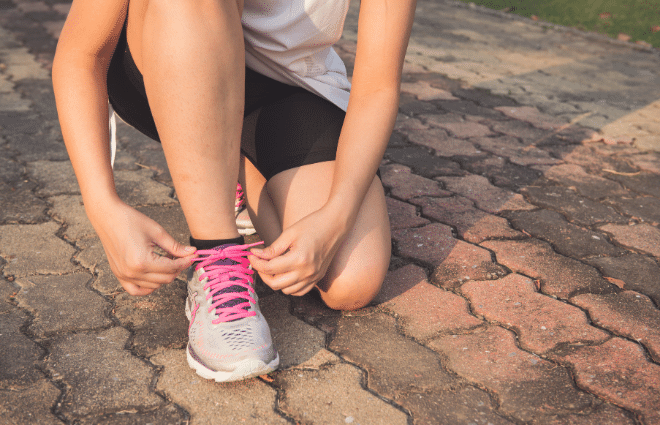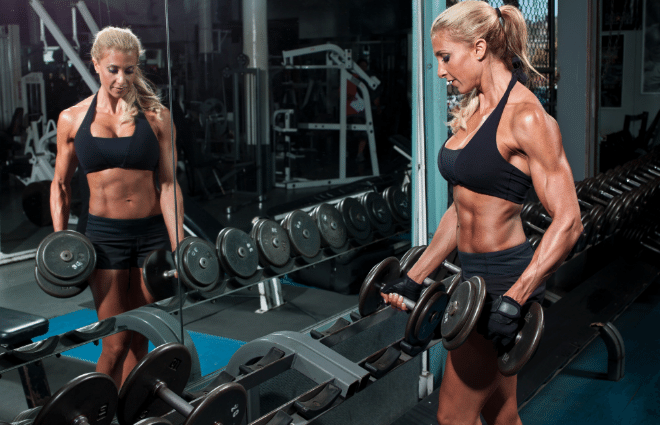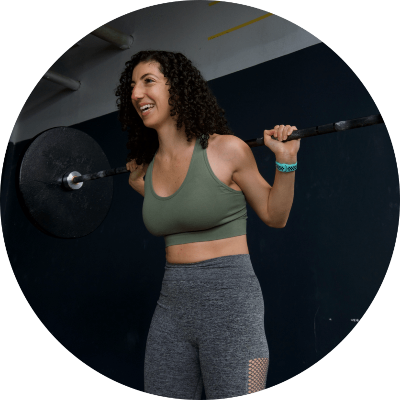The Best Ways to Exercise for Women Over Age 35 [Doctor Explains]
[This is a guest post from Dr. Brittany Robles, MD, of The Postpartum Trainer, about how to exercise after age 35. She shares some great tips and information for anyone interested in improving their health and losing weight after age 35 and beyond.]
Are you over the age of 35 and looking for the best way to exercise?
After reading this post, you will learn:
- Why exercise should be a normal part of your routine,
- The safest way to begin exercise after 35
- How often you should exercise.
Disclaimer
Although I am a doctor, I am not your doctor. This content is for informational purposes only and should not substitute the advice from your healthcare professional. All kinds of exercise and dietary changes are potentially dangerous, and those who do not seek counsel from the appropriate health care authority assume the liability of any loss, damage, or injury which may occur.
This post may contain affiliate links, which helps keep this content free. Please read our disclosure for more info.
What is the Best Way to Exercise After 35?

Believe it or not, almost every woman over the age of 35 should be doing some type of resistance training in an effort to build strength!
By definition, resistance training is a form of exercise in which you work your muscles against some external force.
External forces include:
- Dumbbells
- Kettlebells
- Barbells,
- Your own body weight.
The beauty of this type of exercise is that it can be performed at home, outside, or even in a conventional gym.
The American Heart Association has included at least 2 days of resistance training to their exercise guidelines for all adults.
Strength training is especially important for women, and here’s why.
Why Women Need to Strength Train After 35

There are many reasons why you should exercise regularly, and the reasons become increasingly more important after the age of 35.
Here are the top 5 reasons:
1. Decreases your risk of osteoporosis and bone fractures.
Osteoporosis is a disease that causes your bones to become thin and weak as you age. The biggest complication of osteoporosis is bone fractures.
Unfortunately women achieve their peak bone mass in their 20’s, and begin to show signs of decline shortly after. (1)
Osteoporosis becomes most prevalent in post-menopausal women as estrogen levels fall sharply.
The good news is, resistance training can help decrease bone fracture risk by improving your bone mass and helping to maintain your bone density. (2)
2. Decreases your risk of injury
Engaging in regular physical activity will also strengthen your ligaments, joints, and muscles, which is useful for injury prevention.
This is especially true of the core muscles and hip joint.
A weakened core is a major reason for low back pain in the middle-aged population.
3. Improves mood, self-esteem, & self confidence
Exercise has been shown to have a positive effect on mood.
That’s because exercise:
- causes the release of endorphins (the feel good hormone),
- can improve blood flow and circulation which keeps our cells and brain well oxygenated
- gives you a sense of accomplishment
Studies have even shown exercise to be effective for depression. (3)
4. Improves posture
Do you suffer from neck pain, upper back or low back pain?
A very likely culprit is your posture.
Exercise can help to combat the effects of bad posture by strengthening underused muscles that help keep your body healthy and your posture straight.
This includes the core muscles, glutes, and back muscles!
5. Helps build lean muscle and lower body fat percentage
Finally, exercise will help you build lean muscle tissue.
There is a natural loss of muscle that happens as we get older and restrict our activity levels.
Thankfully, resistance training can reverse this, while improving your metabolism!
As a result, exercise can contribute to a reduction in body fat percentage (although your nutrition will always be more important).
Now that you know why you need to work out, let’s talk about how to get started.
How do I Start Working Out at 35?

To get the most efficient workout, you must learn how to perform the 6 key functional movement patterns:
- Hip extension exercises
- Example: glute bridge and dumbbell deadlift variations
- Knee flexion exercises
- Example: squats and lunges
- Vertical pushing exercises
- Example: shoulder press and similar movements
- Vertical pulling exercises
- Example: pull downs and pull ups
- Horizontal pushing exercises
- Example: push-ups and dumbbell pressing
- Horizontal pulling exercises
- Example: dumbbell rows
The good news is, there are many different exercise variations to train these 6 movement patterns.
The key is to find a variation that is suitable to your skill level and that you can do with proper technique.
I go over several of these exercises along with sample routines over on my blog, Postpartumtrainer.
To get started, I want you to perform one exercise from each of these movement patterns 1-2 times per week.
Which leads me to my next point…
How Much Exercise Should a 35 Year Old Woman Do?

It is recommended that you do 150 minutes of exercise per week, with at least two days of strength resistance training.
I recommend that you try to do resistance training 3-4 times a week, 20-30 minutes per session.
I know that this might sound like a lot, but 20-30 minutes is very doable!
The key is to have a set plan in place for how you are going to approach your workouts.
One simple way to tackle this is:
- going on a 30 minute walk three times per week, and
- doing three 30 minute strength training sessions per week
One workout can be focused on upper body pushing exercises, the other on upper body pulling exercises, and the third one on the lower body and core.
I want you to go into each workout with a plan in place so that your workout can be efficient yet effective.
And if you can’t make it to the gym, most of the exercises mentioned above can be done at home with a set of dumbbells and/or resistance bands.
What Exercises Should You Avoid?
The only type of exercise you should avoid are ones that cause you pain, discomfort, or ones that you cannot perform with proper technique.
There are so many variations to each movement pattern, you can always find an alternative to train the proper muscle groups safely and effectively.
If you are ever unsure, speak with a licensed trainer for personal recommendations for you and your body.
The Most Common Misconception About Exercising After 35

One of the biggest misconceptions women have about working out is the fear of getting bulky.
Thankfully, this is very rare.
It is so hard to get bulky- in fact, people spend years of their lives trying to bulk up.
You see the thing is, not only do you have to exercise A LOT but you also have to eat A LOT.
And most women don’t have high enough levels of testosterone to build a lot of muscle naturally.
So please, don’t let this deter you from making an amazing choice for your body!
Final Words
Exercise is not just important if you are trying to lose weight or get in shape.
It also has many benefits that can be enjoyed by everyone of every fitness level.
If you are over 35 and haven’t yet started, head over to The Postpartum Trainer to start your journey!
And if you’re ready to get started with a full exercise program that’s low-impact, created with middle aged and older women in mind, and perfect for beginners, make sure to check out Avocadu’s Yoga Fat Loss Bible.
It includes detailed, easy to follow yoga workouts to help you lose weight and improve your flexibility and mobility.
About the Author

Hi I am Dr. Brittany Noel Robles, physician and founder of The Postpartum Trainer.
I work full-time as an OBGYN, and I am also a NASM certified personal trainer. I have personally delivered over 500 babies and the most common question I get asked is, “How can I get back in shape postpartum?”
That is why I created The Postpartum Trainer–a health and wellness platform to help moms stay fit during and after their pregnancy.

In an effort to build strength, women over the age of 35 should perform resistance training of some type, but most of them are unaware of its importance or what exercises to perform.
This article discusses how and what exercises should be done for staying healthy and fit. This information is very helpful. Thank you for sharing it.